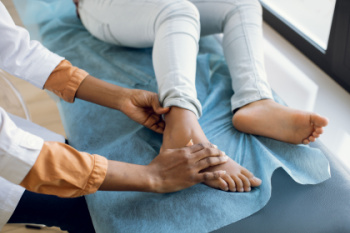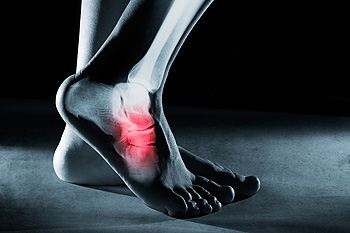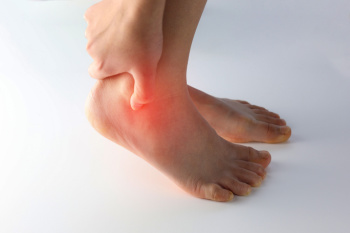Connect With Us
Blog
Types of Infections in the Feet

Foot infections can affect the skin, nails, and deeper tissues of the toes, soles, and ankles when bacteria or fungi enter small breaks in the skin. Fungal infections involve athlete’s foot, which affects the skin between or under the toes, and onychomycosis, which causes thickened, discolored toenails. Bacterial infections include cellulitis, where redness and swelling spread through the skin and abscesses that form painful pockets of fluid. Erythrasma is a bacterial infection that develops between the toes, often appearing as reddish or brown, mildly scaly skin that can resemble a fungal infection. Infections can worsen circulation, limit walking, and increase the risk of joint or bone involvement that sometimes requires surgery to prevent limb loss. A podiatrist can identify the infection type, evaluate its severity, and determine appropriate treatment. If you have developed a foot infection, it is suggested that you make an appointment with a podiatrist for a diagnosis and options for treatment.
When dealing with systemic disease of the feet, it is extremely important to check the affected areas routinely so that any additional problems are caught quickly. If you have any concerns about your feet and ankles contact one of our podiatrists from Foot & Ankle Associates of Maine. Our doctors will assist you with all of your podiatric needs.
Systemic Diseases of the Feet
Systemic diseases affect the whole body, and symptoms usually are displayed in the feet. This condition can make a patient’s ability to walk unbearable. Systemic diseases include gout, diabetes mellitus, neurological disorders, and arthritis.
Gout – is caused by an excess of uric acid in the body. Common symptoms include pain, inflammation, and redness at the metatarsal/phalangeal joint of the base big toe. Gout can be treated by NSAIDs to relieve pain and inflammation, and other drugs that lower the acid levels in the body.
Diabetes mellitus – is an increase in the level of blood sugar that the body cannot counteract with its own insulin. Failure to produce enough insulin is a factor in Diabetes.
Diabetes of the Feet
Diabetic Neuropathy – may lead to damaged nerves and affect the feet through numbness and loss of sensation.
Peripheral Vascular Disease – can restrict the blood flow to the feet, and often times lead to amputation of the feet.
If you have any questions please contact our office located in Brunswick, ME . We offer the newest diagnostic and treatment technologies for all your foot and ankle needs.
Foot Stress Fractures in Runners and How to Prevent Them

Foot stress fractures are tiny cracks in bone caused by repeated impact and overuse rather than a single injury. Runners are especially prone to them because of repetitive loading during training and limited recovery time. Poor training habits, such as rapid mileage increases or lack of rest, can overload the bones. Stress fractures commonly affect the metatarsals, or long foot bones in the forefoot, and may also involve the tibia or shin bone in the lower leg. Female runners may face added risk due to low bone mineral density, which can be influenced by hormonal factors and a low-fat diet that limits bone support. Pain often starts gradually and worsens with activity. A podiatrist can diagnose the injury, guide rest and protection, address training errors, and recommend footwear or orthotics. If running pain persists or intensifies, it is suggested that you schedule a visit with a podiatrist who can offer effective treatment solutions, helping you to run safely.
Stress fractures occur when there is a tiny crack within a bone. To learn more, contact one of our podiatrists from Foot & Ankle Associates of Maine. Our doctors can provide the care you need to keep you pain free and on your feet.
How Are They Caused?
Stress fractures are the result of repetitive force being placed on the bone. Since the lower leg and feet often carry most of the body’s weight, stress fractures are likely to occur in these areas. If you rush into a new exercise, you are more likely to develop a stress fracture since you are starting too much, too soon. Pain resulting from stress fractures may go unnoticed at first, however it may start to worsen over time.
Risk Factors
- Gender – They are more commonly found in women compared to men.
- Foot Problems – People with unusual arches in their feet are more likely to develop stress fractures.
- Certain Sports – Dancers, gymnasts, tennis players, runners, and basketball players are more likely to develop stress fractures.
- Lack of Nutrients – A lack of vitamin D and calcium may weaken the bones and make you more prone to stress fractures
- Weak Bones – Osteoporosis can weaken the bones therefore resulting in stress fractures
Stress fractures do not always heal properly, so it is important that you seek help from a podiatrist if you suspect you may have one. Ignoring your stress fracture may cause it to worsen, and you may develop chronic pain as well as additional fractures.
If you have any questions please contact our office located in Brunswick, ME . We offer the newest diagnostic and treatment technologies for all your foot and ankle needs.
Nighttime Ankle Discomfort and What It May Mean

Ankle pain that appears at night can feel unsettling because it often develops when the body is finally at rest. Some people notice a dull ache after a long day, while others feel sharp twinges that interrupt sleep. This discomfort may come from lingering inflammation, subtle joint irritation, nerve sensitivity, or strain in the tendons that support the ankle. In some situations, swelling becomes more noticeable once the feet are elevated, and in others tight muscles create pressure that becomes clearer when movement slows. Understanding the cause is important because nighttime symptoms can signal early joint changes, overuse, or an untreated injury that needs attention. A podiatrist can examine the ankle, assess strength and mobility, and recommend care that supports healing and reduces irritation. If your ankle pain continues to disturb your rest or worsens over time, it is suggested that you see a podiatrist for an accurate diagnosis and effective treatment solutions.
Ankle pain can be caused by a number of problems and may be potentially serious. If you have ankle pain, consult with one of our podiatrists from Foot & Ankle Associates of Maine. Our doctors will assess your condition and provide you with quality foot and ankle treatment.
Ankle pain is any condition that causes pain in the ankle. Due to the fact that the ankle consists of tendons, muscles, bones, and ligaments, ankle pain can come from a number of different conditions.
Causes
The most common causes of ankle pain include:
- Types of arthritis (rheumatoid, osteoarthritis, and gout)
- Ankle sprains
- Broken ankles
- Achilles tendonitis
- Achilles tendon rupture
- Stress fractures
- Bursitis
- Tarsal tunnel syndrome
- Plantar fasciitis
Symptoms
Symptoms of ankle injury vary based upon the condition. Pain may include general pain and discomfort, swelling, aching, redness, bruising, burning or stabbing sensations, and/or loss of sensation.
Diagnosis
Due to the wide variety of potential causes of ankle pain, podiatrists will utilize a number of different methods to properly diagnose ankle pain. This can include asking for personal and family medical histories and of any recent injuries. Further diagnosis may include sensation tests, a physical examination, and potentially x-rays or other imaging tests.
Treatment
Just as the range of causes varies widely, so do treatments. Some more common treatments are rest, ice packs, keeping pressure off the foot, orthotics and braces, medication for inflammation and pain, and surgery.
If you have any questions please feel free to contact our office located in Brunswick, ME . We offer the newest diagnostic tools and technology to treat your foot and ankle needs.

